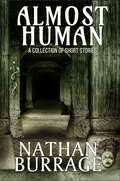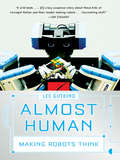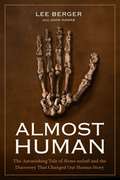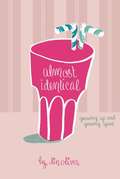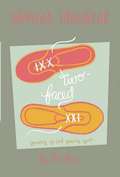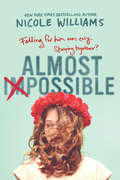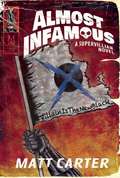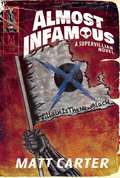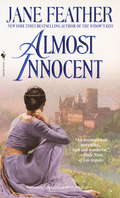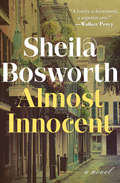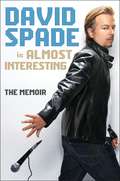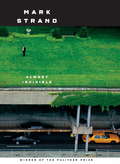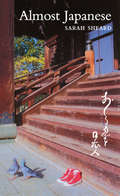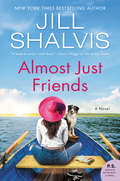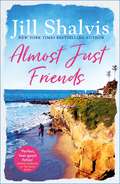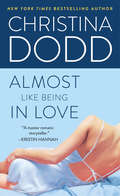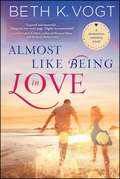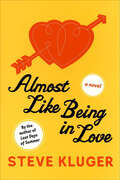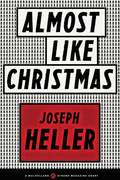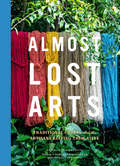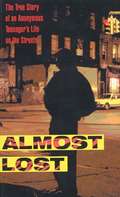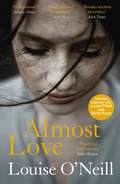- Table View
- List View
Almost Human: A Collection of Short Stories
by Nathan BurrageHumanity: are we really capable of change? Or are we doomed to play out the same Acts over and again, where only the props and backdrops vary?In this collection, you'll encounter stories set in the near future where neuroscience and technology are used to rehabilitate convicted criminals with unexpected results. In the icy winter of a distant Transylvania, a struggle for freedom from Ottoman oppression unfolds. In the present, one man struggles to accept his failed marriage. A pair of cursed lovers live out multiple incarnations, doomed to always find one another, yet never be together. And when a mythical figure walks amongst us, his notes in the margins of history take shape.The past, present and future blur when we consider what it is to be Almost Human.
Almost Human: Making Robots Think
by Lee GutkindA remarkable, intense portrait of the robotic subculture and the challenging quest for robot autonomy. The high bay at the Robotics Institute at Carnegie Mellon University is alive and hyper night and day with the likes of Hyperion, which traversed the Antarctic, and Zoe, the world's first robot scientist, now back home. Robot Segways learn to play soccer, while other robots go on treasure hunts or are destined for hospitals and museums. Dozens of cavorting mechanical creatures, along with tangles of wire, tools, and computer innards are scattered haphazardly. All of these zipping and zooming gizmos are controlled by disheveled young men sitting on the floor, folding chairs, or tool cases, or huddled over laptops squinting into displays with manic intensity. Award-winning author Lee Gutkind immersed himself in this frenzied subculture, following these young roboticists and their bold conceptual machines from Pittsburgh to NASA and to the most barren and arid desert on earth. He makes intelligible their discoveries and stumbling points in this lively behind-the-scenes work.
Almost Human: The Astonishing Tale of Homo Naledi and the Discovery That Changed Our Human Story
by John Hawks Lee BergerIt was the find of a lifetime: The bones of multiple individuals, hidden deep underground in the region of South Africa called the Cradle of Humankind. Only the slimmest expedition members could squeeze through the jagged rock channels to reach the cave and its amazing treasures. In this freewheeling tale of science and exploration, celebrated paleoanthropologists Lee Berger and John Hawks tell the story of how Berger and his team discovered rich caches of fossils representing all-new species on the human family tree. How old are these bones? How did they get so deep underground? What do they tell us about our earliest ancestors? Berger's answers transform our sense of who we are and how we got here.
Almost Identical
by Lin OliverIdentical twins Sammie and Charlie are starting out seventh grade at a brand-new school. As they make new friends, and join different clubs, the sisters (and once inseparable best friends) start to grow further and further apart. Told from Sammie's point of view, this moving yet funny story will be gobbled up by middle-school girls! .
Almost Identical:Two Faced
by Lin OliverWhen Charlie compromises her values to help one of the popular girls cheat on a test, Sammie is inadvertantly pulled into the mess. Written from Charlie's point of view, this story will let readers experience the lengths that wanting to be popular in middle school can take you to, the conflict it can cause, and the tough moral stands a girl sometimes has to take. .
Almost Impossible
by Nicole WilliamsFans of Sarah Dessen, Stephanie Perkins, and Jenny Han will delight as the fireworks spark and the secrets fly in this delicious summer romance from a New York Times and USA Today bestselling author.When Jade decided to spend the summer with her aunt in California, she thought she knew what she was getting into. But nothing could have prepared her for Quentin. Jade hasn't been in suburbia long and even she knows her annoying (and annoyingly cute) next-door neighbor spells T-R-O-U-B-L-E. And when Quentin learns Jade plans to spend her first American summer hiding out reading books, he refuses to be ignored. Sneaking out, staying up, and even a midnight swim, Quentin is determined to give Jade days--and nights--worth remembering.But despite their storybook-perfect romance, every time Jade moves closer, Quentin pulls away. And when rumors of a jilted ex-girlfriend come to light, Jade knows Quentin is hiding a secret--and she's determined to find out what it is."Unique, well-plotted summer romance" --Booklist
Almost Infamous
by Matt CarterEighteen-year-old Aidan Salt isn't a superhero. With his powerful (and unpredictable) telekinetic abilities he could be one if he wanted to, but he doesn't. He's unambitious, selfish, and cowardly, and he doesn't want to have to deal with all the paperwork required to become a professional superhero. But since the money, fame, and women that come with wearing the cape are appealing, he decides to become the first supervillain the world has seen in more than twenty years: Apex Strike.However, he soon finds villainy in a world where the heroes have long since defeated all the supervillains. While half the world's heroes seem to want him dead, the other half want to hire him as their own personal villain to keep them relevant. Choosing the latter course, Aidan enters a world of fame, fortune, and staged superhero fights that is seemingly everything he ever dreamed of . . . at least until he sees what truly hides behind the cape-and-mask lifestyle.
Almost Infamous: A Supervillain Novel
by Matt CarterEighteen-year-old Aidan Salt isn’t a superhero. With his powerful (and unpredictable) telekinetic abilities he could be one if he wanted to, but he doesn’t. He’s unambitious, selfish, and cowardly, and he doesn’t want to have to deal with all the paperwork required to become a professional superhero. But since the money, fame, and women that come with wearing the cape are appealing, he decides to become the first supervillain the world has seen in more than twenty years: Apex Strike.However, he soon finds villainy in a world where the heroes have long since defeated all the supervillains. While half the world’s heroes seem to want him dead, the other half want to hire him as their own personal villain to keep them relevant. Choosing the latter course, Aidan enters a world of fame, fortune, and staged superhero fights that is seemingly everything he ever dreamed of . . . at least until he sees what truly hides behind the cape-and-mask lifestyle.Skyhorse Publishing, under our Night Shade and Talos imprints, is proud to publish a broad range of titles for readers interested in science fiction (space opera, time travel, hard SF, alien invasion, near-future dystopia), fantasy (grimdark, sword and sorcery, contemporary urban fantasy, steampunk, alternative history), and horror (zombies, vampires, and the occult and supernatural), and much more. While not every title we publish becomes a New York Times bestseller, a national bestseller, or a Hugo or Nebula award-winner, we are committed to publishing quality books from a diverse group of authors.
Almost Innocent
by Jane FeatherDear Reader, Almost Innocentis a romance that is particularly dear to me, with a heroine who surprised me with her strength and resourcefulness, and a hero who will always be one of my favorites. Growing up behind the impenetrable walls of an English fortress, young Magdalen does not know that she is the illegitimate daughter of a powerful English prince and his murdered French mistress -- or that she has been a pawn in the struggle between England and France ever since she slipped from her dying mother's womb. All she knows is that she longs for excitement. And then one day, as if in answer to her prayers, the splendid figure of Guy de Gervais, a true knight in shining armor, rides into her cloistered world and spirits her away. For Magdalen it is love at first sight. The one and only love of her life. Yet Guy sees only his responsibility to keep Magdalen safe until she can be wed to his nephew and thus fulfill her political destiny. Then duty calls Guy to the bloody battlefields of France, and when he returns, time has transformed Magdalen into a stunningly sensual beauty. Suddenly the noble knight is fighting the fiercest battle of his life: against a searing desire for a woman he cannot have. I hope that you will be thrilled by Magdalen and Guy's passionate love story, and that you will have as much pleasure reading it as I had writing it. Warmest wishes, Jane Feather P. S. Don't miss my latest novel,The Widow's Kiss, featuring an enchantress who has been widowed no less than four times . . . and the formidable hero who finds himself reluctantly falling under her spell. From the Paperback edition.
Almost Innocent: A Novel (Contemporary American Fiction Ser.)
by Sheila BosworthSheila Bosworth's enthralling debut novel is a vibrant, heartrending story of love and loss set in "the City That Care Forgot" Constance Alexander and Rand Calvert fall in love on Mardi Gras night. She is eighteen years old, the beautiful, privileged daughter of a Louisiana Supreme Court justice. He is a dashing young artist, the son of a family "long on name but short on money." Their desire for each other is intense and irresistible, and when they marry and move into a shabby old house on Camp Street, it is the beginning of a lifetime of happiness together--or so they hope. Decades later, Clay-Lee Calvert seeks the truth about her parents' turbulent romance: their passionate courtship, the resentments created by their impoverished lifestyle, the fatally disruptive influence of Rand's rich, manipulative, and unscrupulous uncle. Clay-Lee also seeks to come to terms with her own role in the tragic events which brought an end to the love story of Rand and Constance, events which have cast a long, dark shadow over her life. A masterful tale of enchantment and anguish in the grand tradition of Southern literature, Almost Innocent sublimely captures the enigmatic allure of New Orleans in the 1950s.
Almost Interesting
by David SpadeI've learned over the last year that books are a lot harder to write than Twitter posts.--@davidspade (free plug)Welcome to my book, guys. Here are 200 pages of my blood, sweat, and jizz. It took a long time to write, and I hope you think it was worth it. These are the stories I tell to my friends or at dinner when I'm drunk and everyone darts their eyes around and squirms in their chair hoping I'll finish soon. Others I've told on Stern or Ellen or anyone else I can name-drop.It's me telling you about my fake problems in life and a few real ones (my neck is actually really a disaster). It is a book about comedy, and how I came up from the dusty roads of Arizona with my OP shorts and my blond fluffy hair, to the mean streets of Beverly Hills, with nothing but a few props in my mom's old honeymoon suitcase and a few dry jokes. I blather on about how I got into stand-up, how I lost my virginity, and meeting Johnny Carson, to my years on Saturday Night Live (I couldn't write decent sketches for shit for a long time), to making Tommy Boy with Farlz, to the time I got the shit kicked out of me by my assistant while I was wearing a Coneheads T-shirt . . . this is my memoir.So, anyway, take a minute . . . to buy this, you don't even have to read it, just gave away all the good parts, anyway. Who reads books, right? Fuck this, let's go do molly at Coachella!
Almost Invisible
by Mark StrandFrom Pulitzer Prize-winner Mark Strand comes an exquisitely witty and poignant series of prose poems. Sometimes appearing as pure prose, sometimes as impure poetry, but always with Strand's clarity and simplicity of style, they are like riddles, their answers vanishing just as they appear within reach. Fable, domestic satire, meditation, joke, and fantasy all come together in what is arguably the liveliest, most entertaining book that Strand has yet written.
Almost Invisible
by Maureen GarvieJewel is on the run from an abusive home situation and furtively living at school. After Maya discovers her classmate’s secret, should she tell? Or can she help Jewel on her own?Thirteen-year-old Jewel has been holding her life together ever since her older sister, Charmaine, suddenly left home with no forwarding address. She tried to find Charmaine once, but that only brought her family to the attention of the police. Now Jewel keeps her head down at school, looks after her special-needs brother as well as she can, and tries to steer clear of her parents and their shady friends.When her father’s friend comes into her bedroom one night, Jewel finally understands why Charmaine had to leave home. Soon she is on the run herself. When her food runs out, Jewel chances upon a new place to live — the cupboard of the art room at school. It turns out to be surprisingly easy to live under the radar when you have perfected the art of being almost invisible.That is, until Jewel’s classmates, Maya and Lily, discover her washing her hair in the girls’ washroom at school and making breakfast in the lunchroom. They take her on as their project, finding her places to sleep, fixing her hair and wardrobe — even as they can’t quite understand her terror, or why she is so afraid of seeking adult help. But the girls help keep Jewel and her secret safe — until they no longer can.Told in the alternating voices of Maya and Jewel, this is a thought-provoking and moving story about loyalty, privilege, keeping secrets, and what it means to be a good friend.Correlates to the Common Core State Standards in English Language Arts:CCSS.ELA-LITERACY.RL.5.6Describe how a narrator's or speaker's point of view influences how events are described.CCSS.ELA-LITERACY.RL.6.3Describe how a particular story's or drama's plot unfolds in a series of episodes as well as how the characters respond or change as the plot moves toward a resolution.CCSS.ELA-LITERACY.RL.6.6Explain how an author develops the point of view of the narrator or speaker in a text.
Almost Japanese
by Sarah SheardIn Sarah Sheard's celebrated novel Almost Japanese, a young girl's obsession with a famous Japanese musician blossoms into personal transformation. In spare, lyrical prose, Sheard documents Emma's discovery of her new next door neighbour, a dazzling Japanese symphony conductor. Things Japanese soon begin to transform Emma's world. Several years later, she must journey to Japan on a private pilgrimage to connect to the source of her obsession.
Almost Just Friends: A Novel (The Wildstone Series #4)
by Jill ShalvisNew York Times bestselling author Jill Shalvis returns to Wildstone with the touching story of finding your place in the world—and the people who make it home.Piper Manning’s about as tough as they come, she’s had to be. She raised her siblings and they’ve thankfully flown the coop. All she has to do is finish fixing up the lake house her grandparents left her, sell it, and then she’s free.When a massive storm hits, she runs into a tall, dark and brooding stranger, Camden Reid. There’s a spark there, one that shocks her. Surprising her further, her sister and brother return, each of them holding their own secrets. The smart move would be for Piper to ignore them all but Cam unleashes emotions deep inside of her that she can’t deny, making her yearn for something she doesn’t understand. And her siblings…well, they need each other.Only when the secrets come out, it changes everything Piper thinks she knows about her family, herself…and Cam. Can she find a way to outrun the demons? The answer is closer than she thinks—just as the new life she craves may have already begun.
Almost Just Friends: Heart-warming and feel-good - the perfect pick-me-up! (The\wildstone Ser. #4)
by Jill Shalvis'Perfect, feel-good fiction' Sarah Morgan on The Lemon SistersIf you love Holly Martin, Jill Mansell and Debbie Macomber, you'll LOVE Jill Shalvis and her irresistible trademark gift for humour, warmth and romance!Jill's books are guaranteed to make you smile:'You can't go wrong with a Jill Shalvis book' 5* reader review'A heartwarming read with all the feels' 5* reader review'Another winner... I cannot wait for more' 5* reader review'A riveting and comforting romance' 5* reader reviewSometimes the life you want is closer than you think. Piper Manning's about as tough as they come, she's had to be. She raised her siblings and thankfully they've flown the nest. All she has to do now is finish fixing up the lake house her grandparents left her, sell it, and then she's free. When a huge storm hits, she runs into a tall, dark and brooding stranger, Camden Reid. The spark between them shocks her. Surprising her further, is the return of her sister and brother, each keeping their own secrets. It would be smart for Piper to ignore them all but Cam unleashes emotions deep inside her that she can't deny. And her siblings...well, they need each other. Only when the secrets come out, it changes everything Piper thinks she knows about her family, herself...and Cam. With the chance of the new life she craves within her grasp, can she find a way to let go and embrace it?Want more warm, funny romance? Check out the Heartbreaker Bay novels starting with Sweet Little Lies, visit stunning Wildstone, gorgeous Cedar Ridge, spellbinding Lucky Harbor or experience some Animal Magnetism in Sunshine, Idaho in Jill's other unforgettable series.
Almost Keto: A Practical Approach to Lose Weight with Less Fat and Cleaner Keto Foods
by Aimee Aristotelous100 recipes, meal plans, and tactics for success! The Keto diet continues to grow in popularity as people across the country are learning more and more about it. However, there is conflicting research regarding the safety of consuming unlimited amounts of items such as bacon, cheese, fatty cuts of meats, and fried pork rinds. A large percentage of Keto dieters find the 70–80 percent fat intake requirement unsustainable, and even worrisome due to potential health implications. Many people are curious about the Keto lifestyle, given the weight loss results they hear about from others, but will not attempt the diet as the fat intake requirement sounds daunting! Almost Keto will provide a formal, lower fat, higher fiber, higher micro-nutrient nutrition plan while still employing cleaner keto-approved foods. It will help readers yield positive weight loss and blood sugar level results while providing a more sustainable and healthier lifestyle. A practical how-to guide with nutrition education (cited with studies), Almost Keto also provides over 100 recipes that incorporate keto-approved foods. Nutritionist Aimee Aristotelous will break down the different types of Keto, the principles and foundation of the diet, as well as niche Keto foods to know and what to eliminate. She will debunk mainstream dietary myths, provide sample meal plans, and offer dozens of delicious, Keto-friendly recipes you'll want to try immediately.
Almost Like A Song
by Ronnie Milsap Tom CarterRonnie Milsap, a legend in country music, shares the story of his life including the obstacles and opportunities created by his blindness. He describes his childhood in the rural south and gives an insider's view of life at a school for the blind. He chronicles his entry into country music and shares stories about his travels.
Almost Like Being in Love
by Christina DoddNew York Times bestselling author Christina Dodd, whose first contemporary novel Just the Way You Are was hailed as "lively, sexy...nothing short of a success" (Publishers Weekly), presents her new novel featuring the Prestcott sisters. As the middle child, Pepper Prescott's rebellious nature helped her survive when her parents disappeared and she and her siblings were sent to different foster homes around the country. Now an independent young woman, Pepper finds herself on the run after witnessing a shooting. Fearing for her life, Pepper flees to the only place she ever considered home and is shocked to find her old lover, Dan Graham, living on the remote mountain ranch. A battle-hardened ex-Special Forces soldier, Dan no longer strikes Pepper as a man she can trust with her secrets, her life, and her love. But as long-simmering desires flare into a deep, sensual passion, Pepper realizes the only way she can reclaim her life is to ally herself with the enigmatic warrior who's willing to help fight for her future by solving the mysteries of her past -- and making her his wife today.
Almost Like Being in Love: A Destination Wedding Novel (Destination Wedding #2)
by Beth K. VogtFrom the author of Somebody Like You, a RITA finalist, and one of Publishers Weekly's top ten books of 2014, comes the story of a woman who has everything for a perfect wedding--except the groom!Winning an all-expenses paid Colorado destination wedding might seem like a dream come true for some people--but Caron Hollister and her boyfriend Alex Madison aren't even engaged. How is she supposed to tell him she's won their wedding and honeymoon when he hasn't asked her to marry him? Being "perfect for one another" seems like the absolute best reason to get married. But what if their supposedly faultless relationship is merely a safe place to protect his secrets and a way to keep their families happy? After quitting her job, Caron accepts her best friend's offer to visit Colorado. She needs to catch her breath. Who knows, maybe visiting the destination wedding site will make a future with Alex seem like a reality. Kade Webster just landed the biggest deal of his life with his company, Webster Select Realty, participating in the Colorado Springs Tour of Homes. He never imagined he would run into the woman who broke his heart--Caron Hollister--right when his career is taking off. Seeing her again, Kade can't help but wonder why Caron walked away from him years ago, leaving him with no explanation. When Kade learns his home stager won't be able to help with the Tour of Homes, he vaults past all the reasons he should stay away from Caron, and offers her a temporary job helping him on the project. This time, their relationship is purely business. Spending time with Kade has Caron questioning everything. The man intrigues her--at times infuriates her--and reminds her of what she lost. Has she been settling for what everyone expects of her? Just because others believe she and Alex are an ideal couple, does that mean they should get married? And how can Caron say "I do" to one man when she's wondering "what if?" about another?
Almost Like Being in Love: A Novel
by Steve Kluger“An engrossing, often laugh-out-loud tale of two unlikely lovers” told in an epistolary style “to brilliant comic and dramatic effect” (Publishers Weekly).A high school jock and nerd fall in love senior year, only to part after an amazing summer of discovery to attend their respective colleges. They keep in touch at first, but then slowly drift apart.Flash forward twenty years.Travis and Craig both have great lives, careers, and loves. But something is missing. . . . Travis is the first to figure it out. He’s still in love with Craig, and come what may, he’s going after the boy who captured his heart, even if it means forsaking his job, making a fool of himself, and entering the great unknown. Told in narrative, letters, checklists, and more, this is the must-read novel for anyone who’s wondered what ever happened to that first great love.
Almost Like Christmas (A Mulholland / Strand Magazine Short)
by Joseph HellerA masterful short story from the acclaimed author of Catch-22, about one long night of anticipation.In a small town in the American South, it is night in the middle of the twentieth century. Carter, a high-school teacher and football coach in the newly desegregated schools, is awaiting news of two of his students who have been in a serious altercation. Outside the building where Carter has kept his vigil, a crowd of townspeople have also gathered to keep watch. Carter must choose how much he wants to participate in the spectacle, and how much he can afford to keep his distance. "Almost Like Christmas" by Joseph Heller is one of 20 short stories within Mulholland Books's Strand Originals series, featuring thrilling stories by the biggest names in mystery from the Strand Magazine archives. View the full series list at mulhollandbooks.com and listen to them all!
Almost Lost Arts: Traditional Crafts and the Artisans Keeping Them Alive
by Emily FreidenrichThis book is a celebration of tactile beauty and a tribute to human ingenuity. In-depth profiles tell the stories of 20 artisans who have devoted their lives to preserving traditional techniques. Gorgeous photographs reveal these craftspeople's studios, from Oaxaca to Kyoto and from Milan to Tennessee. Two essays explore the challenges and rewards of engaging deeply with the past. With an elegant three-piece case and foil stamping, this rich volume will be an inspiration to makers, collectors, and history lovers.
Almost Lost: The True Story of an Anonymous Teenager’s Life on the Streets
by Beatrice SparksWho in his right mind wants to talk to a shrink? I don't want to talk about anything. I don't want to feel anything, taste anything ... or anything. The lyrics "just dying to die" run around in my brain day and night...Fifteen-year-old Sam is in pain. He comes to the therapist's office unwillingly, angry, depressed, and filled with guilt over his own self-destructive behavior. He is being drawn deeper and deeper into a black hole of despair from which he sees no way out.The Road BackThis is the Real-life story of Sam's Recovery, told from tapes of his therapy sessions. It tells what drove him to leave home, how he survived on the street, and why he was desperate to escape from the brutality of the gang that had become his "family" and from the torment of his own self-loathing. For every teen who has experienced the pain and loneliness of a no-way-out darkness, and for all those who love them, here is the light that can lead the way back.
Almost Love: the addictive story of obsessive love from the bestselling author of Asking for It
by Louise O'NeillFor fans of Marian Keyes, Dolly Alderton and Holly Bourne, ALMOST LOVE is one of the most addictive and heartbreaking reads of the year 'Compulsive' Sunday Times'Breaks another boundary' Irish Times'A must-read' Image 'Honest and poignant' Elle 'Intelligent and compelling' Daily Mail When Sarah falls for Matthew, she falls hard.So it doesn't matter that he's twenty years older. That he sees her only in secret. That, slowly but surely, she's sacrificing everything else in her life to be with him. Sarah's friends are worried. Her father can't understand how she could allow herself to be used like this. And she's on the verge of losing her job.But Sarah can't help it. She is addicted to being desired by Matthew. And love is supposed to hurt.Isn't it?
